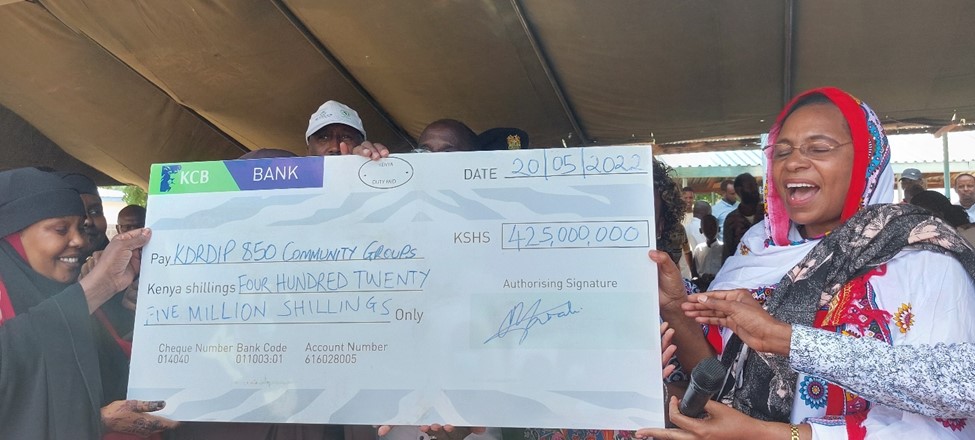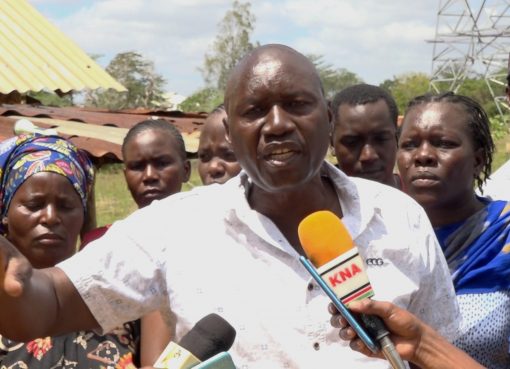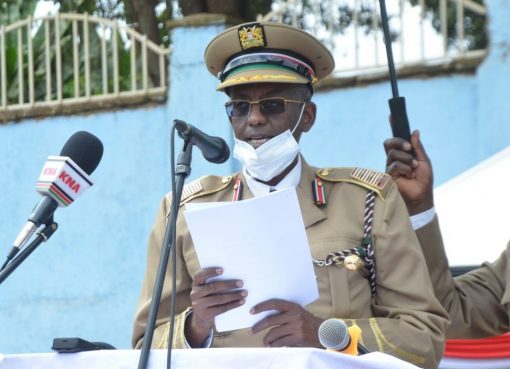A World Bank project, implemented among refugee host communities in Lagdera, Fafi, Dadaab, Wajir South and Turkana West Sub-counties has received praises from leaders in the beneficiary communities as a model that needs to be given serious consideration by development policymakers in Kenya.
Addressing residents of Dadaab after commissioning community projects implemented through Kenya Development Response to Displacement Impact Project (KDRDIP), Cabinet Secretary for Public Service, Youth and Gender Affairs Prof, Margret Kobia said that the project has proved that communities can successfully undertake their development agenda.
“This is one of the projects in the country that enjoys enormous political goodwill, community participation and involvement in its implementation processes. The project has shown that communities have the abilities to identify their own development needs, monitor, supervise and participate fully in the decision making on their development initiatives,” said Prof. Kobia.
The CS thanked the local leaderships and the communities for their continued support, participation and involvement in the project implementation process.
“KDRDIP’s Community Driven Development (CDD) approach has given us very impressive results. The approach has presented opportunities and best practices in community development and governance which may need to be considered when doing national development policies,”
Three MPs from Garissa Mohamed Dahiye (Dadaab), Abdikarim Osman (Fafi) and Mohamed Hire (Lagdera) in whose constituencies the KDRDIP is being implemented asked the national government to extend the project into another phase to cover more areas and support more other emerging development needs.
“I urge the state to engage the World Bank and other donors to secure a phase II of this project,” said Hire, adding that KDRDIP had not only supplemented the CDF projects but also achieved tremendous positive impact on community livelihoods.
In Turkana, leaders said KDRDIP had minimized the hatred and conflicts that existed between the refugees and local communities.
They noted that as a result of the project, more water sources had been established, health facilities improved and school infrastructure developed into modern status.
Wajir County Deputy Governor Ahmed Mukhtar who at the time was acting as the governor said his county had immensely benefited from the project, adding that his County Government would support it to its logical conclusion.
KDRDIP is a National Government initiative, supported by the World Bank to improve the livelihoods of the communities in the vast Dadaab Refugee camp – in Fafi, Lagdera, Dadaab and Wajir South constituencies and Kakuma in Turkana County that have hosted refugees for the past 30 years.
The five-year project was launched in 2017 as part of the regional initiative in the Horn of Africa aimed at minimising impacts associated with refugee presence among host communities. It is implemented in Djibouti, Ethiopia, Kenya, Uganda and Somalia. Kenya is utilizing funds sourced from a World Bank loan of Sh10 billion and additional funding from the Danish International Development Association (DANIDA) of Sh800 million.
According to the Project National Coordinator Dr. Anne Kinyua, the funds have been distributed to a total of 137 villages, spread across 29 wards of the five sub-counties namely Dadaab, Fafi, Lagdera, Turkana West and Wajir South in the three project counties.
At the end of the project Garissa County would have investments totaling Sh. 4 billion, Turkana and Wajir Sh. 3 billion each.
Dr. Kinyua said the project was designed to benefit a combined population of over one million members of the host communities and 400,000 refugees in the five sub-counties.
“So far Sh 7.4 billion has been spent in the last three years to improve infrastructural development, environment and livelihoods in the targeted areas. Another Sh 2.6 billion has been earmarked in the 2022/23 Financial Year to complete the outstanding sub-projects,” explained Dr. Kinyua.
She said some 2500 Community Groups in the target areas had received a grant of Sh. 500,000 each to undertake businesses of their own choices.
She added that the project targeted a total of 1.5 million community members to benefit from improved access to social and economic infrastructure through the support of an investment fund of Sh.4.25 billion, set aside to improve health, education, water availability and access roads.
A total of 360,000 jobs are expected to be created by the end of the project, translating to about 7,500 jobs per sub-county annually.
Dr. Kinyua said 50 percent of the jobs under Labour Intensive Public Works (LIPWs) benefit women, adding that 4000 livelihood groups will be supported through income generating activities such as poultry, beekeeping, milk processing, meat preservation and cottage industries.
This is expected to lead to 128,000 host community members benefiting from increased income as a result of linkages through value chain commodities.
By Erick Kyalo




